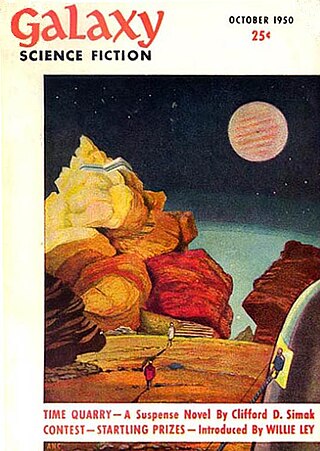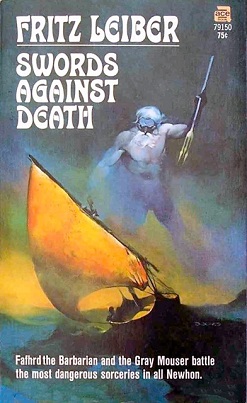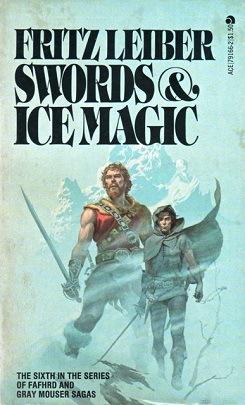
Fritz Reuter Leiber Jr. was an American writer of fantasy, horror, and science fiction. He was also a poet, actor in theater and films, playwright, and chess expert. With writers such as Robert E. Howard and Michael Moorcock, Leiber is one of the fathers of sword and sorcery and coined the term.

Robert Albert Bloch was an American fiction writer, primarily of crime, psychological horror and fantasy, much of which has been dramatized for radio, cinema and television. He also wrote a relatively small amount of science fiction. His writing career lasted 60 years, including more than 30 years in television and film. He began his professional writing career immediately after graduation, aged 17. Best known as the writer of Psycho (1959), the basis for the film of the same name by Alfred Hitchcock, Bloch wrote hundreds of short stories and over 30 novels. He was a protégé of H. P. Lovecraft, who was the first to seriously encourage his talent. However, while he started emulating Lovecraft and his brand of cosmic horror, he later specialized in crime and horror stories working with a more psychological approach.

Galaxy Science Fiction was an American digest-size science fiction magazine, published in Boston from 1950 to 1980. It was founded by a French-Italian company, World Editions, which was looking to break into the American market. World Editions hired as editor H. L. Gold, who rapidly made Galaxy the leading science fiction magazine of its time, focusing on stories about social issues rather than technology.

A paperback book is one with a thick paper or paperboard cover, and often held together with glue rather than stitches or staples. In contrast, hardcover (hardback) books are bound with cardboard covered with cloth, leather, paper, or plastic.

Damien Francis Broderick is an Australian science fiction and popular science writer and editor of some 74 books. His science fiction novel The Dreaming Dragons (1980) introduced the trope of the generation time machine, his The Judas Mandala (1982) contains the first appearance of the term "virtual reality" in science fiction, and his 1997 popular science book The Spike was the first to investigate the technological singularity in detail.

Ballantine Books is a major book publisher located in the United States, founded in 1952 by Ian Ballantine with his wife, Betty Ballantine. It was acquired by Random House in 1973, which in turn was acquired by Bertelsmann in 1998 and remains part of that company today. Ballantine's original logo was a pair of mirrored letter Bs back to back, while its current logo is two Bs stacked to form an elaborate gate. The firm's early editors were Stanley Kauffmann and Bernard Shir-Cliff.
Victor Gollancz Ltd was a major British book publishing house of the twentieth century and continues to publish science fiction and fantasy titles as an imprint of Orion Publishing Group.

Unknown was an American pulp fantasy fiction magazine, published from 1939 to 1943 by Street & Smith, and edited by John W. Campbell. Unknown was a companion to Street & Smith's science fiction pulp, Astounding Science Fiction, which was also edited by Campbell at the time; many authors and illustrators contributed to both magazines. The leading fantasy magazine in the 1930s was Weird Tales, which focused on shock and horror. Campbell wanted to publish a fantasy magazine with more finesse and humor than Weird Tales, and put his plans into action when Eric Frank Russell sent him the manuscript of his novel Sinister Barrier, about aliens who own the human race. Unknown's first issue appeared in March 1939; in addition to Sinister Barrier, it included H. L. Gold's "Trouble With Water", a humorous fantasy about a New Yorker who meets a water gnome. Gold's story was the first of many in Unknown to combine commonplace reality with the fantastic.

Ace Books is a publisher of science fiction (SF) and fantasy books founded in New York City in 1952 by Aaron A. Wyn. It began as a genre publisher of mysteries and westerns, and soon branched out into other genres, publishing its first science fiction title in 1953. This was successful, and science fiction titles outnumbered both mysteries and westerns within a few years. Other genres also made an appearance, including nonfiction, gothic novels, media tie-in novelizations, and romances. Ace became known for the tête-bêche binding format used for many of its early books, although it did not originate the format. Most of the early titles were published in this "Ace Double" format, and Ace continued to issue books in varied genres, bound tête-bêche, until 1973.
Cheap Street Press was an American small publishing company started up in 1980 and operated by the husband-wife duo, George and Jan O'Nale, in their rural home near New Castle, Virginia. Cheap Street concentrated on publishing limited edition books, signed and numbered, of science fiction and fantasy works. Their books were hand-printed letterpress by George on fine paper and hand-bound in fine cloth and leather with matching drop-back boxes.

Hodder & Stoughton is a British publishing house, now an imprint of Hachette.

This is a bibliography of works by American writer John W. Campbell Jr.

Swords and Deviltry is a fantasy short story collection, first published 1970, by Fritz Leiber, featuring his sword and sorcery heroes Fafhrd and the Gray Mouser. It is chronologically the first volume of the complete seven volume edition of the collected stories devoted to the characters. The book was first published in paperback form during 1970 by Ace Books company, which reprinted the title numerous times through November 1985; later paperback editions were issued by ibooks (2003) and Dark Horse (2006). It has been published in the United Kingdom by New English Library (1971), Mayflower Books (1979) and Grafton. The first hardcover edition was issued by Gregg Press during December 1977. The book has also been gathered together with others in the series into various omnibus editions; The Three of Swords (1989), Ill Met in Lankhmar (1995), The First Book of Lankhmar (2001), and Lankhmar (2008).

The bibliography of Herman Melville includes magazine articles, book reviews, other occasional writings, and 15 books. Of these, seven books were published between 1846 and 1853, seven more between 1853 and 1891, and one in 1924. Melville was 26 when his first book was published, and his last book was not released until 33 years after his death. At the time of his death he was on the verge of completing the manuscript for his first novel in three decades, Billy Budd, and had accumulated several large folders of unpublished verse.

Swords Against Death is a fantasy short story collection by American writer Fritz Leiber, first published in 1970 and featuring his sword and sorcery heroes Fafhrd and the Gray Mouser. It is chronologically the second volume of the complete seven volume edition of the collected stories devoted to the characters. It is an expansion of Leiber's earlier collection Two Sought Adventure, issued by Gnome Press during 1957. The earlier collection contained seven of the ten stories of Swords Against Death, plus an "Induction" omitted from the expanded edition, which was instead republished in its companion volume, Swords and Deviltry (1970). Swords Against Death was first published in paperback during 1970 by Ace Books, which reprinted the title numerous times through August 1990; later paperback editions were issued by ibooks (2003) and Dark Horse (2007). It has been published in the United Kingdom by New English Library (1972), Mayflower Books (1979) and Grafton (1986). The first hardcover edition was issued by Gregg Press during December 1977. The book has also been gathered together with others of the series into various omnibus editions; The Three of Swords (1989), Ill Met in Lankhmar (1995), The First Book of Lankhmar (2001), and Lankhmar (2008).

Swords in the Mist is a fantasy short story collection, first published in 1968, by American writer Fritz Leiber, featuring his sword and sorcery heroes Fafhrd and the Gray Mouser. It is chronologically the third volume of the complete seven volume edition of the collected stories devoted to the characters. It was first published in paperback format during 1968 by Ace Books company, which reprinted the title numerous times through September 1990; later paperback editions were issued by ibooks (2003) and Dark Horse (2007). It has been published in the United Kingdom by Mayflower Books (1979) and Grafton. The first hardcover edition was issued by Gregg Press during December 1977. The book has also been gathered together with others in the series into various omnibus editions; The Three of Swords (1989), Lean Times in Lankhmar (1996), The First Book of Lankhmar (2001), and Lankhmar (2008).

Swords and Ice Magic is a fantasy short story collection, first published in 1977, by American writer Fritz Leiber, featuring his sword and sorcery heroes Fafhrd and the Gray Mouser. It is chronologically the sixth volume of the complete seven volume edition of the collected stories devoted to the characters. It was first published in paperback format during July 1977 by Ace Books company, which reprinted the title numerous times through 1990; a later paperback edition was issued by Dark Horse (2007). It has been published in the United Kingdom by Mayflower Books and Grafton. The first hardcover edition was issued by Gregg Press during December 1977. The book has also been gathered together with others in the series into various omnibus editions; Swords' Masters (1990), Return to Lankhmar (1997), and The Second Book of Lankhmar (2001).

The Best of Fritz Leiber is a collection of short stories by American writer Fritz Leiber. It was first published in the United Kingdom by Sphere Books in paperback in May 1974, and in the United States in hardcover by Doubleday in June 1974; a British hardcover and American paperback followed in November of the same year from Sidgwick & Jackson and Ballantine Books, respectively. The Sphere edition was reprinted in June 1977, and the Ballantine edition in September 1979.

G. K. Hall & Co. is an American book publisher based in Boston. It was founded sometime in the late 1950s by Garrison Kent Hall (1917–1973), who also had been an accountant. The firm initially, in the late 1950s through the 1960s, produced catalogs, in print and microform, of collections of renowned libraries – notably the New York Public Library. In the 1960s, Betty Jensen Hall’s new marketing strategy increased profits markedly and the firm expanded, producing other library references in the sciences, humanities, fine arts, and music. Beginning in 1971, two years after being acquired by ITT, the firm became a leading pioneer of publishing large-print editions of best-selling fiction and non-fiction books. In 1972 it acquired Gregg Press the scholarly reprint company. In 1973 it acquired Twayne Publishers. In 1989 it acquired Sandak, the art slide publisher. In 1990 it acquired Thorndike Press, its main American large print competitor.

Nebula Award Stories 3 is an anthology of award-winning science fiction short works edited by Roger Zelazny. It was first published in the United Kingdom in hardcover by Gollancz in November 1968. The first American edition was published by Doubleday in December of the same year. Paperback editions followed from Pocket Books in the U.S. in February 1970, and Panther in the U.K. in November 1970. The American editions bore the variant title Nebula Award Stories Three. The book was more recently reissued by Stealth Press in hardcover in June 2001. It has also been published in German.

















